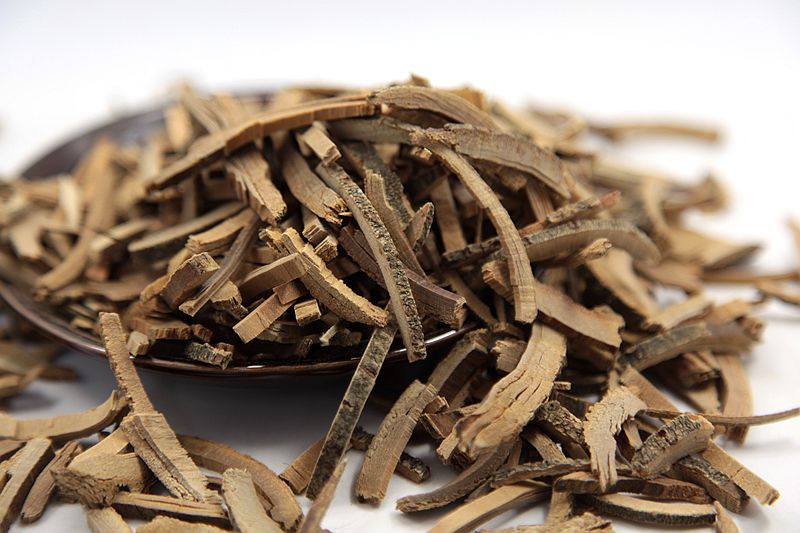Ash tree bark, also known as Qin Pi in mandarin, is an important Chinese herb clinically. The medicinal uses of ash bark can date back nearly 2000 years ago in view of the fact that its medical record was first found in China’s earliest medicinal work – the Divine Farmer's Materia Medica. There it was considered as a medium-grade drug. Actually this herb comes from a number of types of ash trees instead of a specific species. Thanks to the abundant resource, low price, and a variety of pharmacological activities, it is with a wide range of clinical applications, in particular chronic bacillary dysentery, bacterial infection that causes diarrhea, meibomian cysts, Constipation, vaginal discharge, Infantile Epilepsy, Psoriasis, acute hepatitis, chronic bronchitis, whooping cough, and so on.
Ash is the common name of a genus called fraxinus in the family Oleaceae. Based on the statistics, there are 45–65 flowering plants in Fraxinus genus, such as Fraxinus americana (White Ash or Autumn Purple Ash), Fraxinus excelsior (European Ash), Fraxinus nigra (Black Ash), and Fraxinus pennsylvanica (Green Ash), etc. However, when it comes to medicinal uses, it mainly refers to the dried branch cortex from Fraxinus rhynchophylla Hance, Fraxinus chinensis Roxb. Fraxinus szaboana Lingelsh., and Fraxinus stylosa Lingelsh. They are members in the family Oleaceae. Hence, other names of the trees and herb include Bark of Korean Ash Branch, Cortex Fraxini, Ku Li Bai La Shu, Bai La Shu, Jian Ye Bai La Shu, Su Zhu Bai La Shu, and more.
ASH TREE BARK HEALTH BENEFITS
To better get to know the medicinal uses of this herb, let's first compare it in the backgrounds of both western medicine and traditional Chinese medicine. From the point of view of western medicine, modern pharmacological studies have shown that it can inhibit pathogenic microorganisms, reduce inflammation, relieve pain, treat cancer, fight oxidation, and protect nerves and blood vessel.
And TCM wise, Ben Cao Gang Mu (Compendium of Materia Medica) also has a to-the point comments: "Fraxinus bark is clear in color, cold in smell, bitter in taste, and astringent in properties, which makes it an medicine of the Gallbladder Meridian of foot-Shaoyang and the Liver Meridian of Foot-Jueyi. Hence, it treats eye disorders and epilepsy due to it can calm wood; it cures dysentery, metrorrhagia, and leukorrhagia because it is of astringent nature; it heals low sperm counts in men since it is astringent and tonic. This herb is good at treating the above-mentioned 4 kinds of diseases. Unfortunately, the other 3 are overlooked except for the eye-treating property.

Ash Tree Bark
FRAXINUS BARK RECIPES ON HERBAL REMEDIES
Zhong Hua Ben Cao (Encyclopedia of Chinese Materia Medica) says that it is bitter in flavor and astringent and cold in nature. It goes to meridians of liver, gall bladder, and large intestine. Basic functions are clearing away heat and drying dampness, clearing liver-fire to improve vision, and relieving cough and asthma. Primary indications include damp-heat dysentery, morbid leukorrhea, red painful swollen eyes, eye sores, corneal opacity, lung-heat cough and wheezing. Recommended dosage is from 6 to 12 grams in decoction. And externally its decoction or juice can be applied to eyes.
1. Bai Tou Weng Tang from Shang Han Lun (Treatise on Febrile Diseases Caused by Cold). It is combined with Bai Tou Weng (Pulsatilla), Huang Bai (Amur Cork Tree Bark), and Huang Lian (Coptis Root) to treat damp-heat diarrhea and tenesmus.
2. Qin Pi Tang from Wai Tai Mi Yao (The Secret Medical Essentials of a Provincial Governor). It is formulated with Zhi Zi (Gardenia) and Dan Zhu Ye (lophatherum) to cure liver-fire induced red painful swollen eyes and cloudy cornea.
3. Qin Pi Tang from Mi Chuan Yan Ke Long Mu Lun (Secret Ophthalmology of Nagarjuna). It is matched with Gentiana (Qin Jiao), Fang Feng (Radix Saposhnikoviae), etc. to heal hot eyes and corneal ppacification due to wind-heat in liver.

![Diseases, Symptoms, tcm, [tcmwindow.com]](/uploadFile/adImg/2015/11/11/f5cbfcc0-4df5-4646-9b9a-f316651a0199.jpg)





